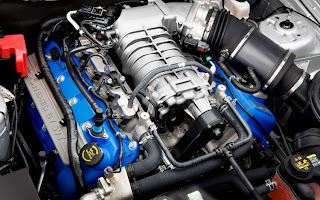 |
| 2011 Ford Shelby GT500 |
2011 Ford Shelby GT500, we're sorry to disappoint. Rather than attempt to reinvent an already very capable wheel, Ford has made incremental improvements to the big snake in an effort to squeeze even more performance out of the GT500's already impressive package. The first and most important stop on the upgrade train is under the hood.
Many had speculated that the GT500 would ditch its old Modular 5.4-liter V-8 in favor of a blown version of the hot new 5.0 that recently debuted in the 2011 Mustang GT (and later supercharged for the new Shelby GT350), but that isn't the case. Instead, Ford's Special Vehicles Team decided that the Lotus philosophy of "add lightness" was the way to go. The 5.4's heavy iron block was shuffled off to the scrap heap, replaced by an all-aluminum version of itself. That little trick alone was good for 102 lbs in weight savings.
Of course, aluminum isn't as resistant to the explosions commonly found inside the internal combustion engine as iron and steel, so aluminum-block engines typically require heavy steel liners for the cylinders. To avoid the extra 8.5 lbs of weight gain steel liners would have added, Ford pioneered a process known as Plasma Transferred Wire Arc coating in which a jet of 35,000-degree plasma melts a steel wire and blows the molten steel against the cylinder walls. As it cools, the steel oxidizes to form a super-strong, iron-iron oxide coating.
Back up the new block with a big 2.75-in. exhaust system, a larger two-row intercooler with 40% more capacity, a forged steel crank, and billet six-bolt mains, and you have a recipe for 550 hp and 510 lb-ft of torque. That's 10 more horsepower than the iron-block powering the outgoing GT500. In addition, 80% peak torque is available from 1,750 rpm to the 6,250 rpm redline. What's more, the new engine picks up 1 extra mile-per-gallon in both city and highway driving for a total of 15 city and 23 highway, good enough to ditch the Gas Guzzler Tax that saddled the 2010 model. All that power gets to the ground through the popular Tremec TR6060 six-speed manual only.
Of course, that's just the base model. If you really want to kick it up a notch, you'll pop for the optional SVT Performance Package. Starting at the corners, the SVT team ditches the stock 19-in. wheels for a set of lightweight forged-aluminum wheels that are 19-in. in front and 20-in. in the rear, cutting 4.7 lbs and 2.8 lbs respectively from the base model wheels. Next, SVT wraps them in Goodyear Eagle F1 SuperCar G: 2 tires that are wheel-specific and made exclusively for the GT500 SVT Performance Package.
2011 Ford Shelby GT500
2011 Ford Shelby GT500
2011 Ford Shelby GT500




















































